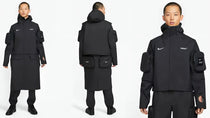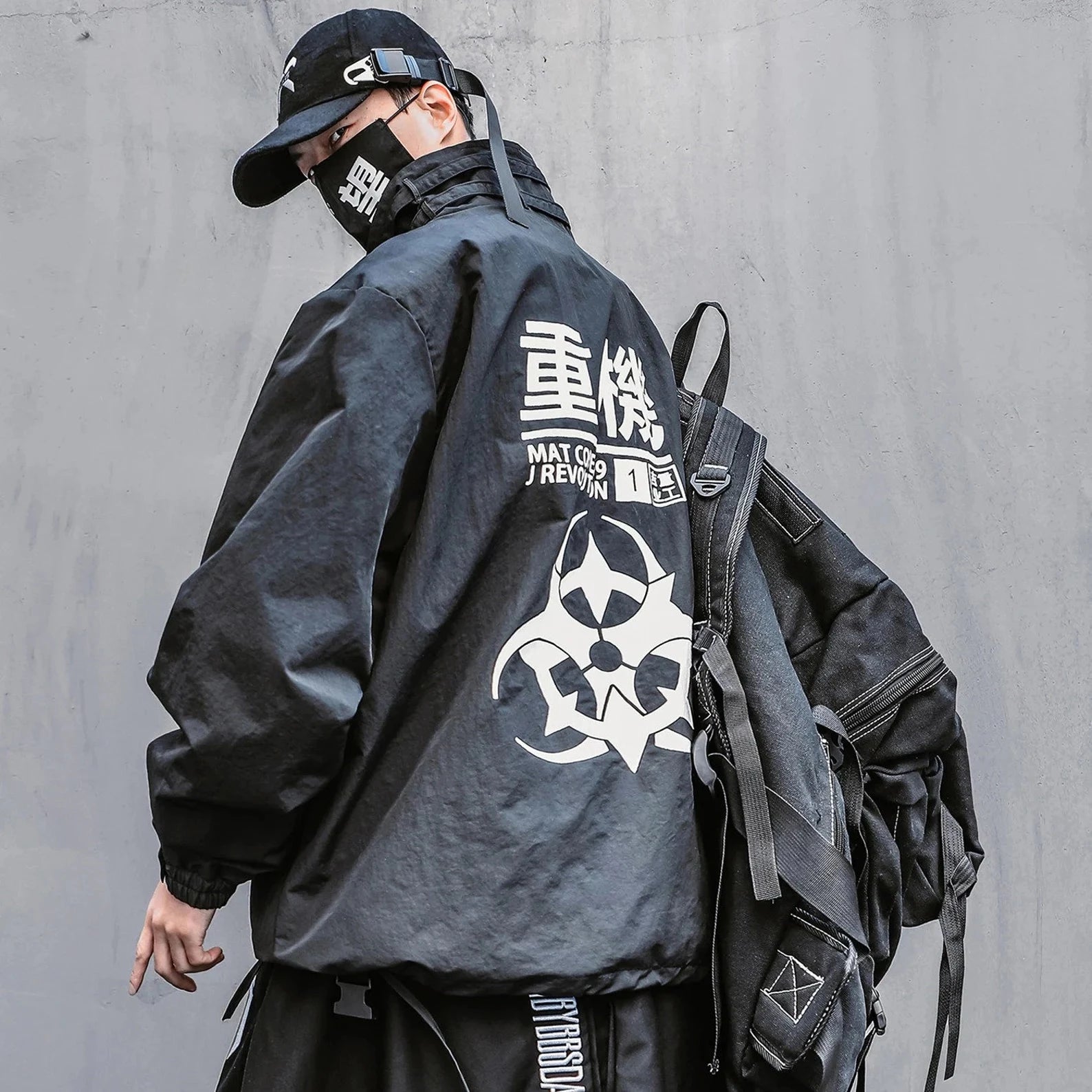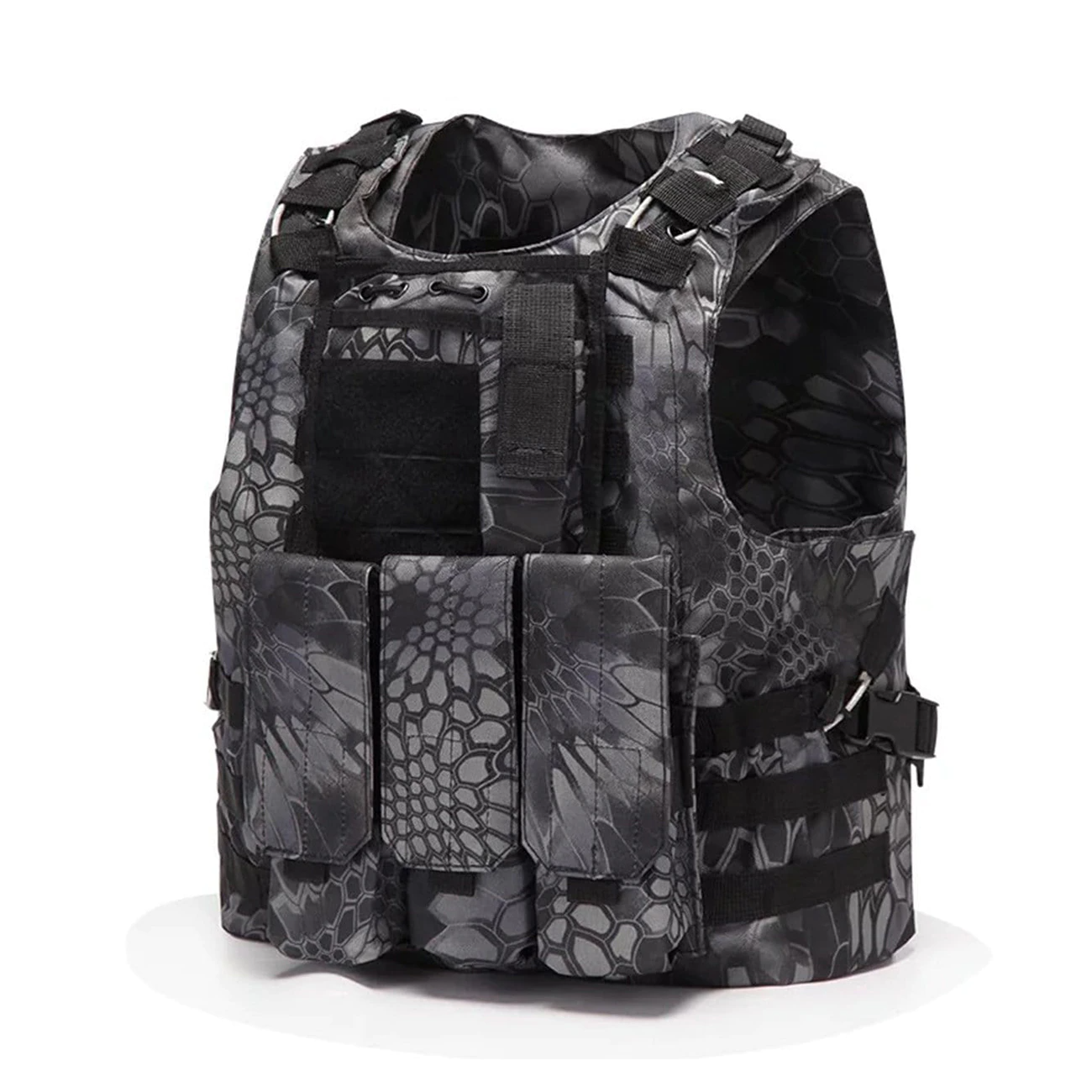Sustainable techwear is technologically integrated clothing produced using environmentally friendly methods and materials. It combines innovative design with eco-conscious practices.
Did you know that manufacturing a typical pair of jeans consumes around 1,800 gallons of water? And that some technical garments incorporate solar panels or kinetic energy converters, allowing wearers to recharge their devices on the move?
Therein lies the paradox. We are consuming more fast fashion (106 billion USD in 2022, expected to be 185 billion in 2027), yet we have many ways of designing and buying sustainable, eco-responsible clothing.
In recent years, many brands — particularly those catering to younger, climate-conscious and streetwear-savvy customers who may be feeling just a little anti-fashion these days — are grappling with a similar philosophical quandary: How to engineer apparel that’s useful in any situation and unisex, but also fashionable — and without stumbling straight into a Navy Seals’ locker room.
But chances are you don't know all these brands and some of them do Greenwashing, falsely claiming sustainability, potentially misleading consumers, and damaging the genuine sustainable techwear movement.
Moreover, striking a balance between aesthetics, functionality, and sustainability can be difficult, as compromises may need to be made in one area to favor another.
Knowing which materials and fabrics to choose to protect the planet isn't any easier.
This article will help you with that, whether you're a consumer or a manufacturer.
The world of techwear is dynamic, and staying updated is the key to true expertise. I regularly attend workshops, seminars, and courses about sustainability in fashion to keep abreast of the latest developments. Plus, I've advocated for transparency, durability, and responsible innovation long before they became industry buzzwords.
By the end of this article, you'll know:
-
what does "sustainable techwear clothing" really mean;
-
why making eco-friendly fashion choices has never been more crucial and what the benefits are for you & the world;
-
what are the eco-responsible materials to look for & how to prevent yourself from greenwashing;
-
which brands are committed to producing eco-friendly functional clothing.
Before you start imagining solar-powered socks and Bluetooth beanies, let’s dive deep into the pockets of sustainable techwear.
What is Eco-Friendly Techwear?
Green Techwear Definition
"Green Techwear" refers to functional, futuristic clothing and accessories designed and manufactured to minimize environmental impact.
Even though impact 0 cannot be achieved, buying and creating with clarity and awareness is essential. Because knowledge is real wealth, and the environmental issue in fashion is an individual matter.
It is a conscious effort we all must make for the greater good.
It is all about doing more with less.
Every techwear piece should be a testament to a brighter, more sustainable future in fashion.
A jacket will never be just a jacket - at least in my eyes and, I hope, in yours.
Why fighting for long-lasting clothing is important?
If you're reading these lines, it's because the question of more ecological fashion in the techwear world is on your mind, which already puts you ahead of many people.
You don't have to join Green Peace to be part of the fight.
Simple gestures and reflexes, which we will cover later in the article, can make a huge difference.
The fight for fairer, more sustainable fashion is a noble cause, and the answer to the 'Why' is quite simple: because consuming clothes responsibly is essential for you, for me and the planet.
But we must redouble our efforts because the situation is only worsening.
Did you know that many non-durable fabrics end up in the bin and that textiles account for 7.7% of municipal solid waste at landfill sites?

Technical clothing and materials aren't inherently unsustainable; they enter this category when paired with high levels of waste.
Synthetic fibers and fabrics are derived from crude oil, a fossil fuel. It is estimated that 62% of all threads in the fashion industry are made from synthetic materials - mainly polyester, nylon, acrylic, polypropylene, and elastane. The global synthetic fibers market is expected to grow at a CAGR (Compound Annual Growth Rate) of 7.39% from 2021-2025.

As you can see from this graph, fast fashion is not about to end.

Especially if people jump from trend to trend more than 50 times a year...

Everyone must become aware of this issue and take responsibility daily to change things.
Benefits of buying environmentally-respectful techwear
Sustainable techwear aims to reverse the impact of mass production and mass consumerism by using environmentally friendly materials, reducing production channels and changing the way products are marketed.
And you can benefit from it in many ways.
-
Environmental Benefits:
-
Conserving natural resources
-
Reducing waste
-
Lessening the fashion industry's carbon footprint
-
-
Functional Benefits:
-
Aesthetically pleasing designs that cater to a range of styles
-
Durable, high-quality materials ensure longevity and less waste
-
Clothing that is both stylish and suitable for a range of outdoor activities
-
-
Fashion benefits: Many sustainable techwear products are so stylish that they become timeless and future-proof. You can wear it for a long time without looking dated.
-
Price benefits: Increasing the demand for eco-friendly techwear clothing will encourage techwear brands to invest time and money. They will create more aesthetic pieces at more affordable prices.
What are the solutions for sustainable technical clothing?
Customers and brands, we all can do something:
-
Reuse techwear products from previous launches by incorporating new collaborations into existing products of the same brand. This will keep products on sale while reducing the production of new products.
-
Reduce the product volume and increase their longevity without their prices becoming exorbitant so customers can still access them.
-
Incorporate non-seasonal styles that reduce the need to buy new products and keep up with recent trends every few months. It has to be paired with a harmonization of customers' fashion choices.
-
Develop a transparent supply chain.
-
Promote the circular economy.
-
Push the industry to implement measures to verify authenticity and prevent the resale of products by unregulated chains. This will ensure that consumers consume products rather than sitting in resale shops until the end of their life cycle.
-
Consume less and do more to promote respect for the environment in the fashion sector.
-
Promoting second-hand products.
-
Create more stylish and aesthetic techwear products to avoid people getting bored quickly.
- Modular clothing

As with many things in life, there are no miracle solutions, but with the commitment of everyone, consumers, and brands, the techwear world will change.
It's not about nature vs. technology. We believe the magic happens when nature meets technology.
Best sustainable materials in techwear clothing
1. Merino Wool

Merino wool is one of the most sustainable and ethical clothing materials. This fantastic fabric is renewable, biodegradable, and requires less care than other performance fabrics. It dries quickly and doesn't retain odors; you can wear it year-round.
If animal welfare is essential to you, know that specific wool certifications exist, like ZQ Merino, which ensures that companies, farmers, and manufacturers follow sustainable and ethical practices. It certifies that the wool comes from "happy sheep".
We suggest you check this certification when buying your next Merino Wool Products.
2. Schoeller DrySkin

Shoellers® was the first activewear manufacturer to receive Oko-Tex Standard 100 certification and serves as one of the founding developers of the bluesign® system, now an industry standard certification for sustainable manufacturing.
The Bluesign system certifies that no harmful chemicals are used in production.
The dual fabric construction developed especially for active sports consists of synthetic fibers on the outside and functional fibers on the inside for rapid moisture transport.
This promotes physical performance during sporting activities.
Properties of the Schoeller Dryskin fabric:
-
breathable
-
wind and water-repellent
-
permanent elasticity
-
hard-wearing and durable
-
moisture transport
-
functional fibers
-
fast drying
-
high level of comfort
Composition: Functional fibres (polyamide, polyester, elasthane).
3. Organic cotton

Cotton is a natural fiber and one of the most common fabrics, but growing it conventionally can cause several problems. It uses a lot of water and chemicals, hurting the environment.
This fabric is grown without pesticides or chemicals and is much more environmentally friendly than ordinary cotton.
For your next purchase, you can verify if it is organic by ensuring it is GOTS-certified (GOTS stands for GLOBAL ORGANIC TEXTILE STANDARD, the leader of organic organizations).
4. Organic flax (linen)

The advantages of organic flax are very similar to those of hemp: it has been grown for hundreds of years, requires little maintenance, and is biodegradable when untreated. Moreover, it's soft, light, solid and even naturally moth-resistant.
Every part of the plant can be used to create linen fabric, meaning minimal waste.
The organic flax manufacturing process is relatively intensive and generates some emissions, but it remains one of the most sustainable options.
5. Recycled fabrics

We briefly mentioned above that recycled cotton is the best kind, and the same goes for many fabrics.
The argument is the same as the one we use to advocate buying second-hand clothes - using recycled fabrics means you're not using new materials or resources and avoiding wasted fabric.
When it comes to polyester, it is even more worth it.
As you may know, traditional polyester is one of the worst fabrics you can buy if your goal is to preserve our planet.
But recycled polyester offers two significant advantages:
-
it is often made from plastic bottles, which reduces the amount of plastic waste.
-
it avoids the intensive process it usually undergoes, saving gallons of water.
Since nothing and nobody is perfect, I'd like to point out that recycled polyester releases microplastics when washed.
Worst sustainable fabrics in the techwear scene
Polyester
Polyester refers to any fabric made from a synthetic, man-made polymer. It means that polyester is essentially plastic, making it the least eco-friendly fabric on the market.
Nylon
Nylon is a silky thermoplastic, often made from fossil fuels, that can be melted and turned into fabric fibers.
Acrylic
Acrylic fabric is made from plastic threads created using fossil fuels like petroleum.
Rayon
Rayon is a fiber that comes from natural wood pulp but requires harmful chemicals to convert it to cellulose, and it can also be dangerous to wear.
Top Brands in Sustainable Techwear
There are several brands today that are taking the issue of ecology and sustainability to heart in the manufacture of their techwear products.
These brands are now committed to:
-
Using environmentally friendly materials, like organic cotton and recycled polyester.
-
Employing production techniques that conserve natural resources.
-
Providing acceptable working conditions and wages for their employees.
-
Aiming to reduce the global carbon footprint of the fashion industry.
While numerous brands are making waves in the sustainable techwear business, some truly lead the charge:
Fjällräven

Fjällräven is probably one of the most sustainable clothing brands you can buy from now.
The Swedish brand respects three main principles.
-
Sustainable design
-
Sustainable materials
-
Sustainable production
"We consider nature when we design; when we choose one material over another; and when we decide where to produce our clothing and equipment.
But it’s not easy. We have to make compromises. We sometimes have to say “no” when we want to say “yes”. We have made, and will continue to make, mistakes. But we try to learn from them; we aim to innovate and adapt. We’re not ones to settle. We never sit back and relax thinking what we’re doing now is good enough. At Fjällräven, the term ‘room for improvement’ is ingrained in all of us.
- the Fjallraven Team.
Houdini Sportswear

Houdini sportswear is entirely ethical in both categories. The company comprises a small team, and the materials they use can be recycled by them when they reach the end of their life cycle.
The team has created "Houdini Reuse" a marketplace for used Houdini garments.
It is a second-hand service that allows customers to buy and sell used Houdini garments, extending their lifetime and reducing the overall environmental impact by lowering the need for new garments.
It’s also a great way for customers to find unique pieces or give new life to unused garments.
Houdini has also created "Houdini Repair", helping its customers to repair their broken garments. It prevents people from throwing aways their clothes too quickly.
Patagonia

Patagonia is a brand synonymous with commitment to the environment. They're a beacon in the fashion industry known for using innovative materials, recycled polyester and other sustainable fabrics to create aesthetic pieces suitable for everyday wear.
Patagonia is well known for offering free returns on all its products, whether on sale or not, at any time.
This policy is extremely effective and prevents a lot of clothing waste.
The North Face

With a commitment to pushing boundaries, The North Face isn’t just about conquering peaks and leading the eco-friendly fashion movement.
From using recycled materials to championing sustainable production processes, their range speaks of quality, functionality, and a promise to the environment.
"Sustainable development is not just a side project. It's at the heart of everything we do. From designing recyclable products to protecting wild spaces for future generations, we are committed to exploring without compromise." - The North Face Team
Columbia

Best known for its outdoor gear, Columbia doesn't compromise on sustainability.
Their techwear line focuses on recycled fabrics, sustainable materials (organic cotton, recycled polyester, and other eco-friendly ones) and production processes that protect natural resources.
Their garments, from jackets to pants, reflect an emphasis on both style and the environment.
"At Columbia, we create sustainable, iconic and innovative products that help people enjoy the outdoors for longer. We combine this approach with our commitment to our consumers, our communities and the environment. We want you to be proud to wear our products every time you go outdoors". - Joe Boyle President of Columbia.
Arc'teryx

A brand that has always resonated with high quality, Arc'teryx’s sustainable techwear range is no different.
Arc'teryx clothing and accessories are a testament to the brand's unwavering commitment to creating stylish pieces that respect nature.
The brand is also a pioneer in innovative materials and strives to reverse the damaging effects of the fashion industry.
To sum up: Each of these brands, in their unique way, is setting the gold standard for sustainable techwear.
From using innovative materials to ensuring environmentally friendly production processes, they're shaping the fashion industry's future, one garment at a time.
Can techwear clothing become 100% green?
At its core, techwear is about the fusion of technology and clothing.
These technological components often involve synthetic materials and complex production processes, which, historically, have been associated with environmental concerns.
With advancements in sustainable technologies and a growing emphasis on environmentally friendly materials, there's potential for a more eco-friendly techwear future.
Brands are already making substantial strides. The landscape is evolving from using recycled polyester to organic cotton and from reducing water usage in production to embracing renewable energy sources.
We can see that sustainable techwear is not just a niche; it's becoming the industry's backbone.
However, achieving complete eco-friendliness is challenging. For techwear to be 100% sustainable, every aspect of the production and disposal lifecycle needs to be environmentally neutral.
This includes sourcing materials, manufacturing, distribution, usage, and even recycling or disposal of the product.
Some stages, especially manufacturing and distribution, come with an environmental cost.
As with any technological domain, innovations in techwear might introduce materials or processes that are initially not eco-friendly, thus requiring further research and adaptation.
It might be ambitious to expect techwear to become entirely eco-friendly in the immediate future. But with continued innovations, collaborations, and a sustained commitment to the environment from brands and consumers, a more sustainable techwear future is in sight.
Wrapping Up: The Future of Fashion is Green and Techy
With the ever-increasing emphasis on protecting the environment and the fashion industry's influence, embracing sustainable techwear becomes not just a choice but a responsibility.
As conscious consumers, the power lies in our hands (or wardrobes) to dictate the future of fashion. Let's make it count.
Responsible Techwear FAQ
Is OFF-WRLD a sustainable techwear clothing brand?
We try to be. OFF-WRLD Techwear Store is an emerging techwear label, and we try our best to reduce the environmental impact by :
-
favoring green delivery methods and durable packaging;
-
multiplying our warehouses worldwide to be closer to our customers and reduce transport time. Also, we select solid and visually appealing products to ensure they will last and you don't get bored of them quickly. We want our products to be"future-proof". We intend to collaborate with brands and craftsmen who use organic materials.
Many of our techwear jackets and techwear accessories are sustainable, especially our Avant-Garde Bag.
Is Uniqlo sustainable techwear?
Uniqlo is not classified as a "Sustainable Techwear Brand" because sustainability is not, like other brands, its unique priority.
However, one can say that the brand has made a lot of effort recently and is doing way better than most well-known brands, especially in the fast-fashion sector.
Uniqlo has initiated various sustainability projects, such as recycling down and wool, promoting sustainable materials like organic cotton, and implementing water-saving production methods for their denim. They also have the "Uniqlo U Recycled Down" collection, which uses reclaimed down from used products.
Finally, Uniqlo does carry tech-forward products, especially in their "LifeWear" concept. Some lines, such as the HEATTECH, AIRism, and BLOCKTECH collections, incorporate technological features for functionality and comfort.


























